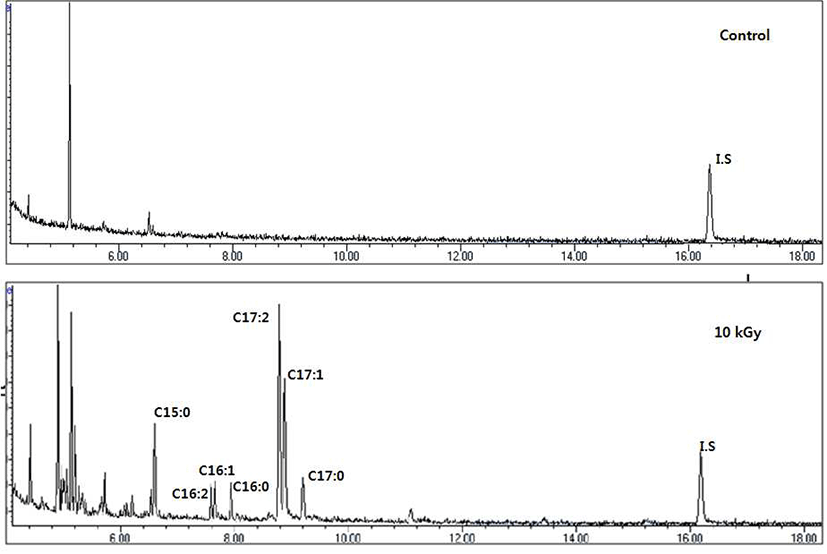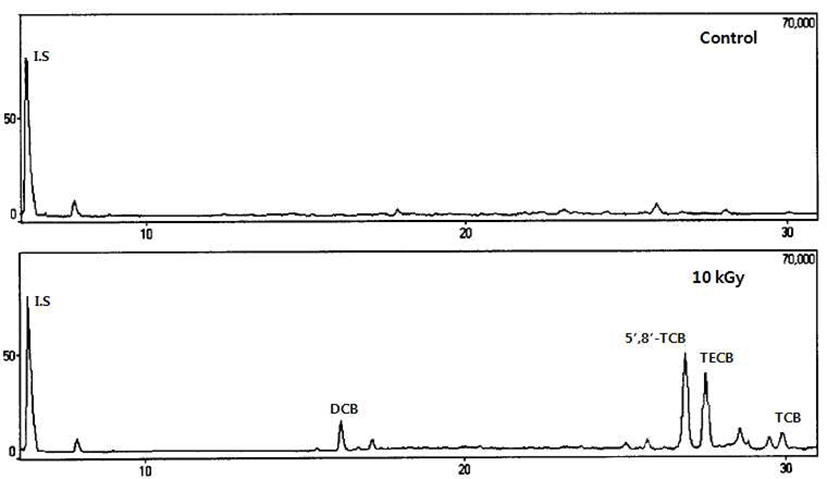서 론
방사선 조사기술이 식품의 위생화 기술로서 식품의 관능 적인 품질에 큰 영향을 주지 않으면서 식품의 질과 안전성 을 향상시키는데 효과가 크다고 보고(1) 된 이후, 세계적으 로 방사선 조사식품의 실용화에 대해 관심이 높아졌다. FAO/IAEA/WHO 등의 국제기구에서 평균 10 kGy 이하로 조사된 모든 식품에 대해 안전성을 발표한 바(2) 있어, 잔류 독성이나 오존층 파괴와 같은 환경상의 문제점이 지적되고 있는 화학 보존제와 훈증제(methyl bromide, ethylene dibromide, aluminum phosphide, ethyl oxide 등)의 대체기술 로 방사선 조사기술을 권장하고 있다(3). 여러 선진국에서 는 자국의 식품가공원료 및 제품의 품질을 높이고자 방사선 조사기술을 활용하고 있으며(4), 우리나라도 1987년 감자, 양파, 마늘 등의 발아억제를 목적으로 처음 시작하여 현재 건조식육 및 어패류 분말, 건조채소류, 곡류 및 두류 등 총 26품목을 방사선 조사 허가식품으로 허용하고 있다(5).
견과류는 미국의 시사주간지 타임(Time)이 선정한 10대 건강식품 중 하나로 미국 식품의약국(FDA)은 호두, 아몬드 와 같은 견과류 함유제품에 심장질환의 위험을 감소시키는 효과가 있다는 내용의 표시를 허용하였다(6). 호두(Juglans nigra)는 아몬드 다음으로 소비량이 큰 견과류(7)로서 linoleic acid와 oleic acid 등의 불포화지방산이 다량 함유되 어 있다(8). 최근 건강에 관심이 많은 사람들에 의해 주목받 고 있으며 지질, 단백질과 함께 무기질까지 풍부한 영양원 으로 알려지면서 식품은 물론 화장품 등에도 널리 사용되고 있다(9). 웰빙트렌드로 지난 5년간 소비량이 꾸준히 증가하 고 있으나, 그에 따른 국내생산량이 이를 충족하지 못해 2013년을 기준으로 소비량의 약 90%에 해당되는 1만 2천 톤을 미국(9,775톤, 88.7%)과 칠레(1,164톤, 10.6%)에서 수 입하고 있는 실정이다(7). WHO/FAO/IAEA 및 Codex 등 관련 국제기구의 식품조사 국제합의규격에 의하면 견과류 는 식품군 3에 속하여 해충구제, 미생물 감균을 목적으로 0.3~5.0 kGy 까지 감마선 조사가 허용되어 있다(10). 그러나 우리나라의 경우 밤을 제외하곤 아직 견과류에 관련된 조사 기준은 없는 상태이다(5). FTA 체결 이후 국가 간 식량자원, 식품원료, 가공품 및 방사선 조사식품 등의 교역이 날로 증가되고 있어 기준이 다른 품목의 경우 관리가 필요하다. 식품의 유통관리를 위해 방사선 조사여부를 확인할 수 있는 기술 또한 많이 연구되고 있으며, 현재까지 연구된 방사선 조사식품에 대한 검지방법은 물리적인 방법, 생물학적 방 법, 화학적 방법 등(11)이 있다. 그 중 지방을 함유한 식품의 경우 지방산이나 triglyceride 유래 생성물인 hydrocarbon류 와 2-alkylcyclobutanone류의 분석이 활용될 수 있다고 보고 되었고(12-16), 이를 통하여 방사선 조사식품의 조사여부 확인방법으로 연구되고 있다(17-22).
본 실험은 호두에 감마선을 선량별로 조사시켜 생성된 hydrocarbon류와 2-alkylcyclobutanone류를 분리, 확인하여 생성량을 비교분석함으로써 감마선 조사여부와 흡수선량 추정을 위한 marker로서 이용가능성을 확인하고자 하였다.
재료 및 방법
본 실험에서 사용한 시료는 광주광역시 풍암동에 위치한 농산물공판장에서 진공포장되어 판매되는 국내산 깐호두 를 구입하였으며, 한국원자력연구원 첨단방사선연구소 내 선원 10만 Ci의 60Co 감마선 조사시설에서 시간당 2.5 kGy 선량률로 각각 1, 3, 5, 7 및 10 kGy의 총 흡수선량을 얻도록 조사하였다. 흡수선량의 오차는 ±0.02 kGy 이고, 이를 비조 사 시료와 함께 -18°C에 저장하며 실험에 사용하였다.
본 연구에 사용한 모든 시약은 특급시약으로 미국 Sigma 사 (St. Louis, MO, USA)에서 구입하였고, 지방분해산물인 hydrocarbon류와 2-alkylcyclobutanone류의 standard는 독일 TeLA사(Karlsruhe, Germany)로부터 구입하였다. 지방추출 및 chromatography에 사용한 n-hexane 등의 유기용매는 Fisher Scientific (Pittsburgh, PA, USA)에서 HPLC grade를 구입하여 이를 wire spiral packed double distilling 장치 (Normschliff Geratebau, Germany)로 재증류하여 사용하였 다. Florisil(60-100 mesh, Fisher Scientific) 550°C 회화로에 서 하룻저녁 태운 뒤 desiccator에서 식힌 후 hydrocarbon류 와 2-alkylcyclobutanone류 분리를 위해 각각 3%와 20% 증 류수를 가하였다. 이를 evaporator를 이용하여 충분히 균질 화하고 12시간 이상 방치하여 불활성화 시킨 후 column 충진제로 사용하였다.
분쇄기를 이용하여 균질화한 시료 30 g을 Na2SO4와 함께 Thimble filter(Whatman, 26 mm×10 mm)에 넣고 재증류한 hexane 100 mL과 함께 soxhlet 장치에서 10시간 이상 추출 하였다. 추출용매는 rotary vacuum evaporator(Büchi, Flawil, Switzerland)와 N2 gas를 이용하여 잔존유기용매를 모두 제 거하고 냉동보관하여 실험시료로 사용하였다.
호두의 지방산 조성 분석을 위해 식품공전(26)에 준하여 BF3-MeOH에 의한 methyl ester화 방법을 이용하였다. 추출 된 조지방 약 25 mg에 0.5 N NaOH 1.5 mL를 가하여 혼합한 후 100°C에서 5분간 가열하였다. 이를 냉각하여 BF3-MeOH 용액 2 mL를 가하였고, 다시 100°C에서 30분간 가열해 methyl ester화 하였다. 이어 isooctane 1 mL를 가하여 교반 하였고 포화 NaCl 용액 5 mL를 가하여 혼합 후 방치하였다. Isooctane 층을 분리하여 무수 Na2SO4로 수분을 제거하고 여과한 후 N2 gas 기류 하에서 농축하여 분석하였다.
불활성화된 florisil 25 g을 200×20 mm chromatography column에 충진시키고 재증류한 n-hexane 60 mL를 3 mL/min의 유속으로 conditioning한 후 추출지방 1 g에 internal standard로 n-eicosane(4 μg/mL, n-hexane) 1 mL를 첨가하여 column에 넣은 뒤 30 mL n-hexane을 용리용매로 하여 hydrocarbon류를 분리하였다. 이 용리용매를 rotary vaccum evaporator로 약 5 mL까지 농축시키고 N2 gas로 0.5 mL까지 서서히 농축하였다.
불활성화된 florisil 30 g을 200×20 mm chromatography column에 충진시키고 재증류한 n-hexane 150 mL를 3 mL/min의 유속으로 conditioning한 후 추출지방 0.2 g에 internal standard로 2-chclohexylcyclohexanone(1 μg/mL, n-hexane) 1 mL를 첨가하여 column에 넣은 뒤 2% diehtylether/ n-hexane 혼합용매(v/v) 120 mL 를 용리용매로 하여 2-alkylcyclobutanone류를 분리하였다. 이 용리용매를 rotary vaccum evaporator로 약 5 mL까지 농축시키고 N2 gas로 0.5 mL까지 서서히 농축하였다.
분리된 hydrocarbon류 분석에 사용한 GC/MS 분석기기 는 Thermo Polaris Q(Thermo Finnigan, Austin, TX, USA)로 분석하였으며, 시료의 이온화는 EI(electron impact ionization) mode로 실시하였다. 사용한 column은 DB-5(30 m×0.32 mm i.d., 0.25 μm, J&W Scientific, Folsom, CA, USA)이며, ionization voltage는 70 eV으로 하였고, injector와 ion source 온도는 각각 250°C로 설정하였다. 분석한 분자량의 범위 (m/z)는 40~350으로 하였다. 온도 program은 60°C에서 17 0°C까지 25°C/min 속도로, 205°C까지 2°C/min 속도로 승온 시키고 다시 10°C/min 속도로 270°C까지 승온시켰다. Carrier gas는 helium을 사용하였으며, 유속은 1.0 mL/min으 로 하였다. Hydrocarbon류 분석을 위해서는 시료 1 μL를 주입하고 split ratio는 초기에 splitless, 2분 이후 split 1 : 20으로 하였다. 분리된 성분의 확인은 total ionization chromatogram에 분리된 각 peak의 성분분석 결과와 표준물 질인1-tetradecene(C14:1), pentadecane(C15:0), 1-hexadecene(C16:1), 1,7-hexadecadiene (C16:2), 1,7,10-hexadecatriene(C16:3), heptadecane (C17:0), 8-heptadecene(C17:1), 6,9-heptadecadiene(C17:2)(Sigma Aldrich)의 분석에 의한 mass spectrum 및 retention time을 비교하여 확인하였으며, internal standard로 첨가한 n-eicosane으로 정량하였다. 실험은 3회 반복하여 측정하였 으며 평균값 ± 표준편차로 결과를 나타내었다.
2-Alkylcyclobutanone류 분석에 사용한 GC/MS 분석기기 는 Shimadzu QP-5050(Shimadzu, Tokyo, Japan)을 사용하였 으며, 시료의 이온화는 EI 방법으로 행하였다. Full scan mode로 정성분석을 하였고, 정량분석을 위해 GC/MS의 SIM(selected ion monitoring) 방법을 이용하였다. 시료는 2 μL를 주입하였고 split ratio는 1 : 20으로 하여 처음 1분 동안 splitless 하였다. Ion source temperature는 270°C로 하 였으며, 분자량 범위와 column 종류는 hydrocarbon류 분석 과 동일하게 하였다. 온도 program은 120°C에서 1분 동안 유지하고 15°C/min 속도로 160°C까지, 0.5°C/min 속도로 17 5°C까지, 30°C/min 속도로 290°C까지 승온시켜 10분간 유지 하였다. Carrier gas는 helium을 사용하였으며, 유속은 1.0 mL/min로 하였다. 표준물질은 2-Dodecylcyclobutanone (DCB), 2-tetradecylcyclobutanone(TCB) 2-(5’-tetradecenyl) cyclobutanone(TECB) 및2-(5’,8’-tetradecadienyl)cyclobutanone (5’,8’-TCB)을 0.1~10 ppm (μg/mL n-hexane)으로 조제하였 고, internal standard인 2-cyclohexylcyclohexanone은 1 ppm 농도가 되도록 하여 표준검량선을 작성하였다. DCB와 TCB는 ion m/z 98, 112를, TECB와 5’,8’-TCB는 ion m/z 67, 81, 98 및 109를 설정하여 시료에서 분리된 2-alkylcyclobutanone류와 표준물질과의 retention time과 ion ratio를 비교, 확인하여 정량하였다.
결과 및 고찰
호두의 지방추출 분석결과 100 g당 62.18 g의 조지방이 함유되어 있었고, 포화지방산은 6.53 g, 불포화지방산 50.68 g으로 검출되었다(Table 1). 호두의 지방산 조성 분석결과 는 linoleic acid를 비롯하여 총 8종이 확인되었다. 그 중 linoleic acid가 53.7%로 호두 지방산의 대부분을 차지하고 있었으며, oleic acid(17.7%), linolenic acid(9.7%), palmitic acid(6.7%)의 함량이 그 다음으로 높았다. Hydrocarbon류와 2-alkylcyclobutanone류는 이러한 지방산에 방사선조사를 시킴으로서 일정한 분해기전을 통해 생성되는 화합물이다. 즉, hydrocarbon류는 중성지방의 carbonyl기의 α- 및 β-탄소 의 위치에 결합이 끊어져 Cn-1 과 Cn-2 형태의 화합물이 생성 되며, 2-alkylcyclobutanone류는 C2 위치에 alkyl기를 가진 cyclic 화합물이 생성되는 것으로 알려져 있다(27).
감마선 조사된 호두로부터 유도된 hydrocarbon류를 분 리, 분석한 결과를 Table 2에 나타내었고, 비조사 및 10 kGy로 조사된 시료의 chromatogram을 Fig. 1에 나타내었다. 감마선 조사된 호두에서 검출된 hydrocarbon류의 함량을 비교해보면 호두의 지방산 조성에서 가장 많은 양을 차지하 고 있는 linoleic acid에서 유도된 8,11-heptadecadiene(C17:2) 의 생성량이 가장 높았고, 다음으로 oleic acid에서 유도된 8-heptadecene(C17:1)의 함량이 높게 확인되었다. 이는 본 연 구의 분석 결과인 지방산 조성에 의한 결과로 보여지며, 다른 연구들(17-25)에서도 이러한 유의성이 확인된 바 있 다. Palmitic acid에서 유도된 hydrocarbon류는 pentadecane (C15:0)이 1-tetradecene(C14:1)보다 더 높게 검출되었고 stearic acid에서 유도된 hydrocarbon류 heptadecane(C17:0)이 1-hexadecene(C16:1)보다 높게 확인되었다. 또한 oleic acid에서 유도된hydrocarbon류인8-heptadecene(C17:1)이1,7-hexadecadiene (C16:2)보다 높은 함량으로 검출되었고, linoleic acid에서 유 도된 8,11-heptadecadiene(C17:2)이 1,7,10-hexadecatriene (C16:3)보다 높게 검출되어 Cn-1 hydrocarbon 류의 높은 생성 률을 확인하였다. 이러한 결과로 호두에 방사선 조사를 하 면 hydrocarbon류가 지방산 β-탄소 위치보다는 α-탄소 위치 에서 더 많이 생성됨을 알 수 있었다. 생성된 hydrocarbon류 는 1 kGy 이상으로 조사된 시료에서 모두 검출되어 방사선 조사의 유무를 확인할 수 있었고, 선량별 유의성은 oleic acid에서 유도된 8-heptadecene(C17:1)와 linoleic acid에서 유 도된 8,11-heptadecadiene(C17:2) 및 1,7,10-hexadecatriene (C16:3)이 조사선량과 생성량의 linear regression 상수(r2)가 0.93 이상으로 높은 상관성을 나타내었다. 따라서 이러한 결과로 1 kGy 이상 방사선 조사된 호두의 조사여부를 분석할 수 있는 마커로서 활용 가능성이 높을 것으로 판단되었다.

감마선 조사된 호두로부터 유도된 2-alkylcyclobutanone 류를 SIM 방법에 의해 정량분석한 결과는 Table 3에 나타내 었고, 비조사 및 10 kGy로 조사된 시료의 chromatogram은 Fig. 2에 나타내었다. 2-Alkylcyclobutanone류 또한 감마선 조사에 의해 유도된 hydrocarbon류와 같이 조사선량에 따 라 함량 변화를 보였다. 함량을 비교해보면 호두의 지방에 많이 함유되어 있는 linoleic acid로부터 유도된 2-(5’,8’-tetradecadienyl)cyclobutanone(5’,8’-TCB)가 가장 많이 확인 되었고, oleic acid로부터 유도된 2-(5’-tetradecenyl) cyclobutanone(TECB), stearic acid에서 유도된 2-tetradecylcyclobutanone(TCB), palmitic acid에서 유도된 2-dodecylcyclobutanone(DCB)가 순서대로 높게 확인되었 다. 방사선 조사된 호두에서 유도된 2-alkylcyclobutanone류 는 linoleic acid와 oleic acid로부터 유도된 5’,8’-TCB 및 TECB가 가장 많이 확인되어 이는 지방산 조성에 의한 결과 로 판단하였다. 방사선 조사에 의해 유도된 DCB, TCB, TECB, 및 5’,8’-TCB는 1 kGy 이상으로 조사된 시료에서 모두 검출되어 방사선조사의 유무를 확인할 수 있었다. 조 사선량이 증가함에 따라 유도화합물 함량의 증가를 확인하 였으며, 특히 5’,8’-TCB와 TECB는 linear regression 상수(r2) 가 0.95 이상으로 조사선량와 높은 상관성을 보여주었다. 따라서 이를 통해 2-cyclobutanone류 중 linoleic acid와 oleic acid에서 유도된 5’,8’-TCB 및 TECB가 1 kGy이상 방사선 조사된 호두의 조사여부를 분석할 수 있는 확인 마커로서 활용 가능성이 높을 것으로 판단되었다.

요 약
본 연구는 호두를 대상으로 감마선을 1-10 kGy 선량으로 조사시켜 생성된 hydrocarbon류와 2-alkylcyclobutanone류 를 통해 방사선 조사여부를 확인하였다. 지방은 soxhlet방 법으로 n-hexane을 추출용매로 사용하였고 florisil이 충진 된 column으로 분리하여 gas chromatography / mass spectrometry(GC/MS)로 확인하였다. 감마선 조사된 호두에 서 검출된 주요 hydrocarbon류는 oleic acid에서 유도된 8-heptadecene과 linoleic acid에서 유도된 8,11-Heptadecadiene, 1,7,10-Hexadecatriene이었고, 검출된주요2-alkylcyclobutanone 류는 linoleic acid와 oleic acid에서 유도된 2-(5’,8’- tetradecadienyl)cyclobutanone(5’,8’-TCB), 2-(5’-tetradecenyl) cyclobutanone(TECB)가 가장 높은 함량으로 확인되었다. 조사된호두에서생성된hydrocarbon류와2-alkylcyclobutanone 류의 생성량은 선량에 비례하여 증가하였으며, 이 화합물 들은 1 kGy 이상 조사된 시료에서만 나타났으며 비조사 시료에서는 확인되지 않았다. 따라서 방사선 조사에 의해 oleic acid과 linoleic acid에서 유도된 hydrocarbon류 중 8-heptadecene, 8,11-Heptadecadiene 및 1,7,10-Hexadecatriene, 2-alkylcyclobutanone류 중 5’,8’-TCB 및 TECB는 감마선 조사 여부의 확인을 위한 marker로서 활용가능성이 높게 나타났다.